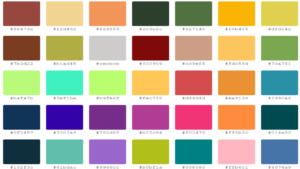Color theory is a set of principles and guidelines that help artists, designers, and individuals understand how colors interact with each other and how they can be combined to create aesthetically pleasing visual compositions.
Color theory involves the study of color relationships, color mixing, and the psychological effects of colors on human perception. Here are some key components of color theory:
- Color Wheel:
- The color wheel is a circular diagram of colors arranged by their chromatic relationship. It serves as a visual representation of the color spectrum.
- Primary colors (red, blue, and yellow) are spaced evenly around the wheel. These colors cannot be created by mixing other colors.
- Secondary colors (green, orange, and purple) result from mixing equal parts of two primary colors.
- Tertiary colors are created by mixing a primary color with a neighboring secondary color.
- Color Harmony:
- Color harmony refers to the pleasing arrangement of colors in a way that is visually appealing. Different color harmonies are achieved through specific relationships on the color wheel.
- Common color harmonies include:
- Analogous: Colors that are next to each other on the color wheel.
- Complementary: Colors that are opposite each other on the color wheel.
- Triadic: Three colors that are evenly spaced around the color wheel.
- Tetradic (Double-Complementary): Two sets of complementary colors.
- Color Attributes:
- Hue: The type of color, such as red, blue, or green.
- Saturation: The intensity or purity of a color. Fully saturated colors are vivid, while desaturated colors are more muted.
- Brightness (Value): The lightness or darkness of a color.
- Color Schemes:
- A color scheme is a predefined selection of colors used in a design or artwork. Common color schemes include monochromatic, analogous, complementary, and triadic.
- Monochromatic: Uses variations in lightness and saturation of a single color.
- Analogous: Uses colors that are adjacent to each other on the color wheel.
- Complementary: Uses colors that are opposite each other on the color wheel.
- Triadic: Uses three evenly spaced colors on the color wheel.
- Psychological Effects of Colors:
- Colors can evoke emotional responses and influence perceptions. For example, warm colors like red and yellow are often associated with energy and warmth, while cool colors like blue and green can convey calmness and tranquility.
- Cultural and personal experiences can also influence the way individuals perceive and interpret colors.
- Color Mixing Models:
- Different color models, such as RGB (Red, Green, Blue), CMYK (Cyan, Magenta, Yellow, Key/Black), and HSL (Hue, Saturation, Lightness), provide different ways to represent and manipulate colors, depending on the application.
Understanding color theory is essential for artists and designers as it helps them make informed decisions about color choices, creating visually appealing and harmonious designs. It also provides a common language for discussing and analyzing colors in various creative fields.








